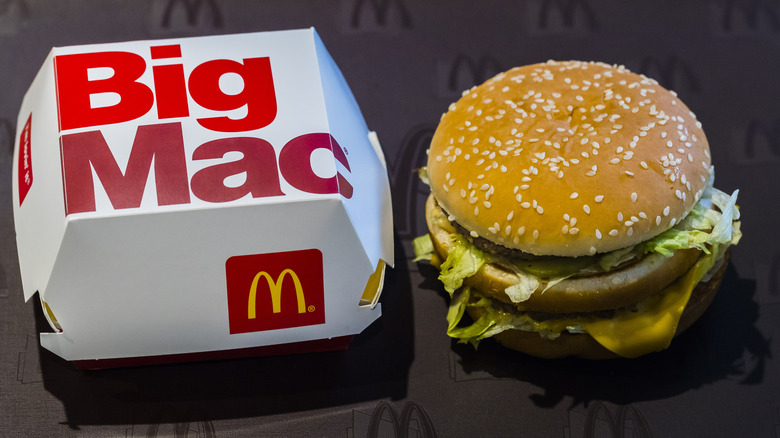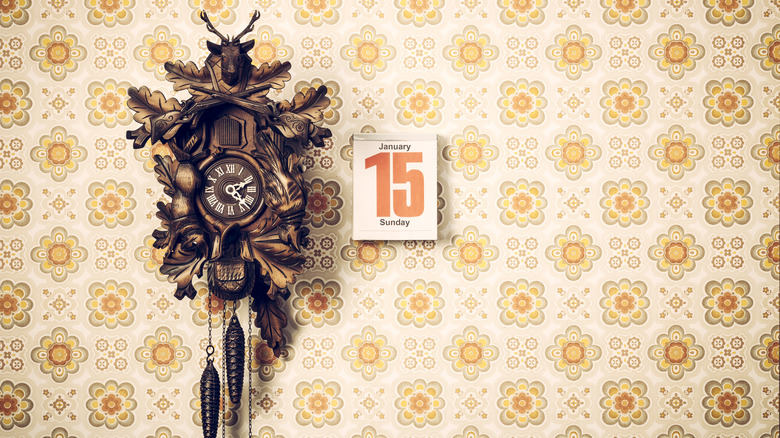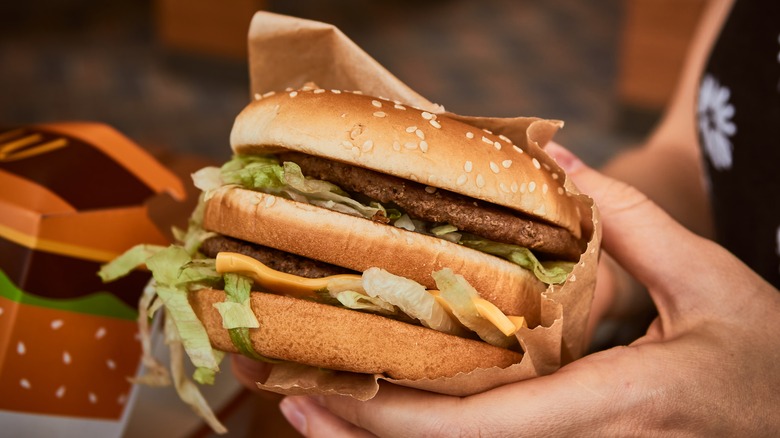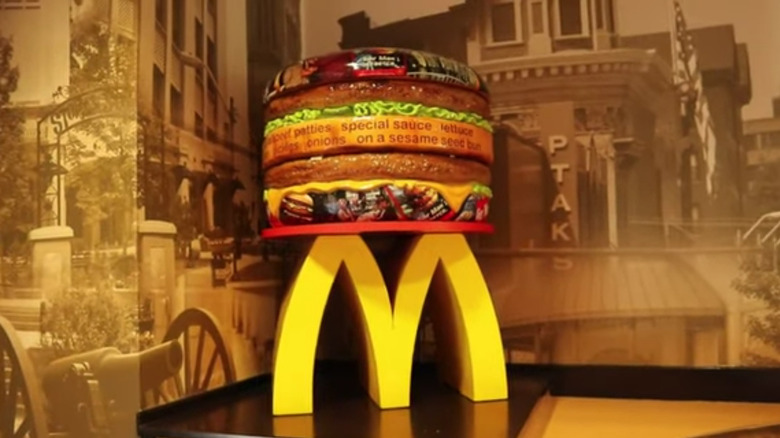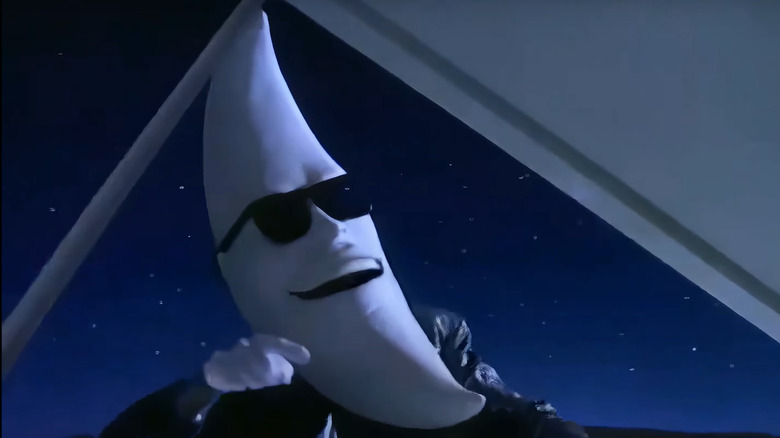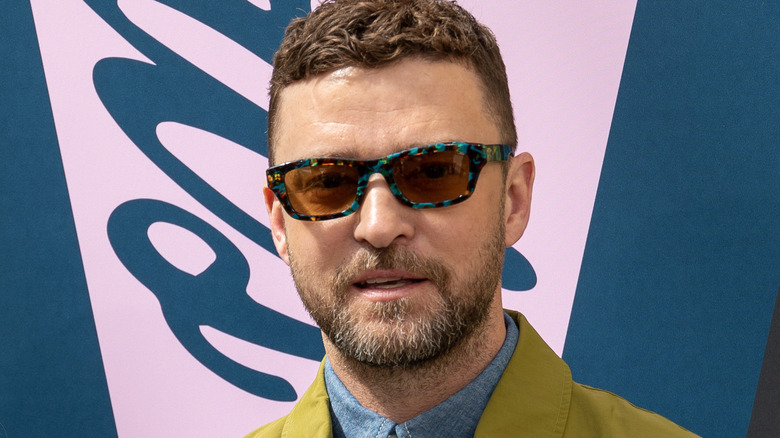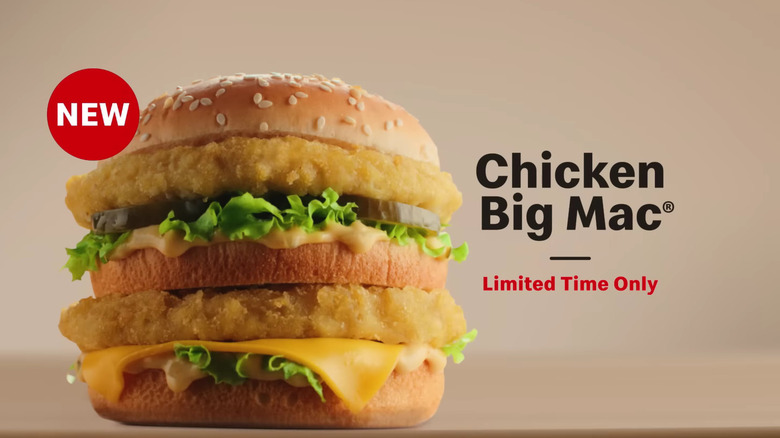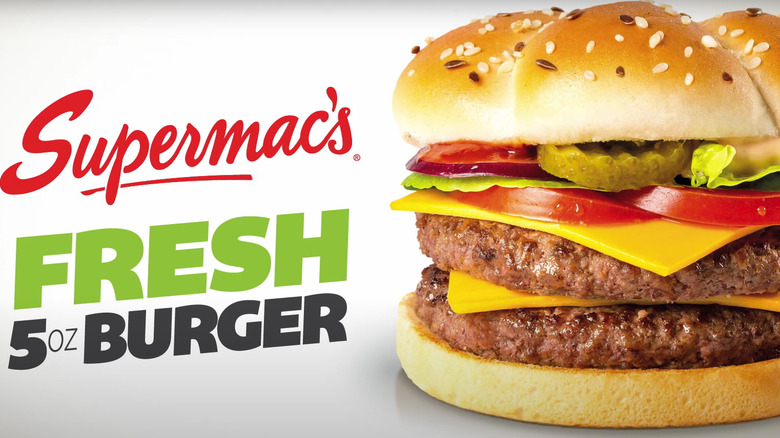Here's Why McDonald's Stopped Using The Big Mac Song
The invention of the Big Mac gave McDonald's a lot to sing about. Created by a McD's franchisee, Jim Delligatti in Uniontown, Pennsylvania in 1967, it went against the prevailing trends of the time. Aside from the fact that it came in at twice the size and the price of the chain's original assembly line hamburger and despite the fact that it introduced some foreign ingredients, like the special sauce and the sesame seed bun, to the mix, it became a hit almost immediately. Today, people worldwide can enjoy the savory taste, which is largely why the loaded hamburger is responsible for roughly 20% of the chain's sales worldwide, per Fortune.
In light of this, it isn't any wonder that this wonder of a burger got its own jingle in 1974 when an ad exec saw the now-famous list of ingredients — "two all-beef patties, special sauce, lettuce, cheese, pickles, onions on a sesame seed bun" — via the Burger Gazette, aka, college newspapers. While it wasn't exactly a high culture moment of, say, someone thinking, "Wow, that Maya Angelou poem would make a great song," the chanty phrase of ingredients suggested song to the exec, nonetheless, and the Big Mac song was born. Although the lyrics to the chain's long-time "I'm Lovin' It" campaign have replaced the Big Mac song as the jingle of choice, the nostalgic among us still remember the Big Mac song fondly and wonder what happened to it. If you're among them, here's the scoop.
It wasn't a jingle originally
Here's a mnemonic device whose validity is backed by science. If you want to remember something, you only need to add music. This explains why jingles like the Big Mac song become the earworm that bangs around in your head in the middle of the night. On their own, the words to the song might be difficult to remember. It may also be why saying "Supercalifragilisticexpialidocious" doesn't burn the Disney song into your memory in the same way that the vocal strains of Julie Andrews' voice do when she sings it as a song in "Mary Poppins."
But the lesson doesn't just apply to difficult Disney lyrics. It's fundamental to the ad world, too. It was Mcdonald's creative director, Keith Reinhard, who is Chairman Emeritus of DDB Worldwide, who saw the musical potential of "Two all-beef patties, special sauce, lettuce, cheese, pickles, onions on a sesame-seed bun." At the time, his burst of verbal inspiration was splashed all over college and university newspapers. He suddenly thought, "I simply must make that into a song." Okay. He probably didn't say those exact words, but he was onto something when the inspiration struck to set the words to music. While it may be difficult to believe that the sing-songy recipe list introduced via TV commercials in 1974 and 1975 was just some other textual McDonald's ad slogan, it really didn't start out as a song, despite seeming like the perfect one for a famous burger.
The jingle appeared in 1974 and only for a year and a half
Because the Big Mac song has such an infectious tune and lyrics, it's likely that those who remember it believe that McD's used it for years and years and years. However, the hamburger giant didn't use it for decades or even a handful of years. The jingle spieled across the airwaves for just a year and a half. To put that into perspective, the McD's jingle "You Deserve a Break Today" started running in 1971 and played on and off throughout the decade — and the decades that followed. Shoot. The Big Mac song didn't even get the kind of advertising notoriety that other trends of the 1970s did. The Six Million Dollar Man doll? Yeah. It blasted TV airwaves for three years before sliding into oblivion.
Granted, that was a toy, not a song jingle, even if it did have its 15 minutes of fame. However, even if you compare apples to apples, that is — jingle to jingle — the Big Mac song has jingled us longer than most ads. And given the Big Mac song's sheer airplay time compared to "You Deserve a Break Today," you'd think that the latter instead of the former would stream into our consciousness more often than it does. But that's the magic of a good lyric combined with a catchy tune.
Most McD's ad campaigns last four years or less
As far as time spent on the airwaves, the Big Mac song is pretty much average, maybe even below average. Until the fast food giant rolled out its "I'm Lovin' It" campaign, no McDonald's ad campaign — and any song that went with it — lived longer than four years. Granted, jingles like "You Deserve a Break Today" have been revived from zombie-land from time to time, only to slink back to the shopping malls from whence said jingle zombies came.
As far as marketing and ad campaigns go, four years is a pretty long time. Typically, they last a year or two, even some of the more remarkable ones, and not just those created by McDonald's. When Wendy's unveiled its "Where's the Beef" campaign, it lasted just a year or so initially. It ran from 1984 to 1985 though the burger chain has revisited it from time to time. Incidentally, that's one of the reasons why McDonald's current "I'm Lovin' It" campaign is so remarkable. It's been running going on 20 years now.
The Big Mac came into being in 1967
Although McDonald's started in 1955, it was another 12 years before it got its best-selling item, the Big Mac. It took another seven years after that for the sandwich to get its own song. This was no top-down invention. Rather, a franchisee in Pennsylvania, Jim Delligatti, created the billion-dollar burger in his store. Initially, the powers that be were skeptical that it could even sell. For one thing, at a cost of $0.45, his burger cost nearly double that of the original McDonald's hamburger, which sold for $0.18. Delligatti got explicit instructions to use only ingredients that could already be found in your average local McD's. That would have been all fine and well, except that Delligatti's concoction wouldn't fit the undersized buns that were standard issue for the chain. That's when he slid a sesame seed bun in under the radar. The special sauce was his thing, too.
Despite the initial skepticism surrounding the burger, it sold well. Within a year, it appeared on McDonald's menus around the country. A secretary named Esther Glickstein gets credit for the burger's name. Before it became the Big Mac, it was almost "The Aristocrat," which sounds more like something out of a Disney movie than an offering from a burger joint, (though now, with all the Happy Meal and Disney crossovers as part of the most savory McDonald's ad campaigns of all time, it's maybe not such a stretch). What has remained since its inception are the ingredients that formed the basis for the Big Mac song.
The campaign has a spot in the Big Mac Museum
Any sandwich that sells 550 million units each year deserves its own museum, and happily, one exists in Irwin, Pennsylvania. Naturally, since this is McD's we're talking about, said museum doesn't have stuffy curators dressed in dark blue suits, just waiting to take your tickets at the door of a Louvre-like establishment. Nope. It's in a McDonald's, right there in Penn. And between bites of Big Macs washed down with Coke, you can walk through a visual history of the Big Mac. Some discord has arisen over the location of the museum, given that the very first Big Mac came to life about 40 miles away in Uniontown, Pennsylvania.
Ad campaigns, including the one that brought us the Big Mac song, get their due in a 3D timeline of sorts. The Mona Lisa of this museum is the giant 14-foot Big Mac replica and a giant — though not as giant as the 14-foot number, Big Mac, with the lyrics to the Big Mac song scrawled across its front. Like the assembly line that inspired the first McDonald's, much of the display is also laid out in assembly lines. You can catch sight of the Big Mac box's different iterations and bobblehead replicas of Jim Delligatti and the rest of the Delligatti management team. And while the Big Mac Meal you buy on the restaurant side of the museum may cost you, admission to the museum is free.
Each decade has seen its own ad campaigns
When your favorite fast food jingle, like the Big Mac song, wiggles its way through your head, you probably don't think much about the song's origin. This demonstrates how effective an ad campaign can be. But the truth is, many factors influence the success of an ad and even why a company like McDonald's would switch from one campaign to another. For example, pushback against fast food companies advertising foods that make you fat led to a slew of menu changes and, therefore, a slew of ad changes. Social media's influence also impacted fast food ads. And, of course, in recent years, the effects of the pandemic played a big role in fast food advertising. More specifically, fast food companies advertise directly to the consumer via the company's mobile app. And marketing, in these instances, is filtered through the app holder's personal preferences. In other words, a vegetarian won't get the same ads as an ardent steak lover because app holders tell companies what they want to see.
When viewed in this light, it's easier to understand why McDonald's would change not only its ad campaigns with each decade but every couple of years. That the Big Mac song was preceded by "You Deserve a Break Today" and followed by a crescent moon singing lounge songs is just par for the course in the world of food advertising. As food trends change, the types of ads must change, too.
McDonald's tried to revive the campaign two separate times
For a fast food ad jingle like the Big Mac song, retirement isn't really retirement. It's just the downtime between gigs. Granted, it might be decades between gigs, but still — such is the case with this jingle. It had its heyday in the 1970s. Then came much more fun ad campaigns, like "Toy Story" Happy Meals and adults taking a much-needed break from office politics to have a bite of dopamine-inducing fatty foods to cope with said politics, so McD's didn't need the Big Mac song.
But occasionally, even the best ad guys run out of good ideas. When that happens, they recycle, and an old stand-by like the Big Mac song gets pulled out of retirement. It happened in 1994, 2003, 2005, and again in 2008. The 2008 attempt tried to bring kids who'd never grown up with the song into the fray by creating a campaign earmarked for MySpace. That year, in general, was big on nostalgia advertising. Klondike Bar tried to raise an old campaign out of retirement slumber. As for the 2003 attempt, that may have been linked to trying to revive sales by going with an old standby. The year prior, McDonald's lost money for the first time ever, and not just a little bit. As of the first quarter of 2002, it was down $344 million dollars. If ever there's a time to play on people's nostalgia for an ad, that would be it.
The revival attempts overlapped with other campaigns
"Two all-beef patties, special sauce, blah, blah, blah" is snappy and all, but it ain't Justin Timberlake singing "ba-da-ba-da-da." As it turns out, even the attempted revival of the Big Mac song in 2003 paled in comparison to other ad campaigns that McDonald's aired around it during the early part of the 21st century. In this case, McDonald's hired Justin Timberlake to release a full-length video of the song "I'm Lovin' It," which, as lovers of all things McD's know, is the company's long-running ad campaign. It was a crafty release. Timberlake released the song with nary a mention of the worldwide burger joint. That mention of the fast-food giant came after the song was a hit. The cameo cost McD's $6 million, but considering the campaign's success over its 20-year run, the Timberlake appearance was a bargain.
The release of the new campaign marked a turning point for McDonald's advertising. Before adopting "I'm Lovin' It," the fast-food giant had never used a commercial intended for a worldwide audience. The Big Mac song celebrates one aspect of the business: Its double-decker sandwich. There's a drawback to approaching ads in that way. Namely, it doesn't speak to cultural differences worldwide and how that affects their food preferences. Today, "I'm Lovin' It" is McDonald's billion-dollar baby. In the campaign's first year, the company's sales jumped, yanking it out of any remaining sales slumps and earning Ronald's restaurant nearly $2 billion worldwide.
The campaign's list of ingredients is part of the Big Mac trademark
That catchy list of ingredients isn't just the lyrics to the McDonald's song. It's a part of its legal status around the world. In other words, McDonald's has those ingredients trademarked. This gets tricky when, say, a hamburger company in Australia called Big Jack's creates a burger and, in its advertising campaign, has described the burger as "two flame-grilled 100% Aussie beef patties, topped with melted cheese, special sauce, fresh lettuce, pickles and onions on a toasted sesame seed bun." Sounds suspiciously familiar, right? Or close enough to make the powers that be at McDonald's mad as a hornet in a water fight.
That's the challenge with trademarks. If one company — company "A" — creates a product that's not significantly different from another company's product — company "B" — so much so that the similarities between the two products might fool the public into thinking they're the same, then company "A" might be found guilty of trademark infringement. This is the argument that McDonald's is making against Big Jack's. McDonald's takes its ingredients-as-trademark seriously. However, as the company makes more inroads in countries around the world, this issue becomes even larger when you consider that the ingredients list for the Big Mac sometimes changes depending on the country where it's being sold. Enforcing the trademark becomes even trickier then.
Different countries have different ingredients for the Big Mac
So, if you consider yourself a dyed-in-the-wool foodie, it ain't no thang to try some exotic cuisines when you cross borders. You live for it. Crave the experience. But if you've traveled enough, you also know what it's like to want a big bite of some familiar home-grown food. Maybe you're hankering after a Taco Bell bean burrito. Or maybe it's Pizza Hut pizza you want. Or maybe you just want to bite into those two all-beef patties after a long day of sightseeing. Fortunately, a visit to McDonald's isn't out of the question. McDonald's is in 100 countries, with only about 13 where you absolutely won't find a McDonald's, so getting your Big Mac attack satisfied shouldn't be a big issue, right?
The short answer is not necessarily. In many countries, you can get the Big Mac mostly as you know it — but in some countries, that's not possible. Due to regional and cultural differences, the ingredients in the Big Mac change. Egypt is said to have the most unhealthy Big Mac because the burgers weigh more. In Israel, you can't get a Big Mac with a slice of cheese because dairy and meat don't mix in the kosher world (but it's also the most healthy out of all Big Macs). And in India? Yeah. You don't get beef at all because the Indians think cows are literally holy. It's against religious and cultural norms to eat beef there. So what do restauranteurs do instead? Why, they make the burger with chicken (or lamb!) instead of beef.
The Big Mac name lost a trademark dispute in the EU
While Shakespeare may contend that a rose by any other name would still smell as sweet, differentiating names amongst rival businesses in the 21st century often takes a more sour-smelling turn. The Big Mac found itself on the receiving end of a European trademark dispute in the years leading up to 2019. In 1998, McDonald's registered the Big Mac's trademark in Europe with the World Intellectual Property Organization (WIPO). It's worth remembering that one of the jobs of the trademark is to ensure that no rival company creates a product or business too similar to another company's product or business. This ensures that the two entities won't confuse the burger-buying public.
Enter Supermac's, a burger chain with about 100 stores in Ireland and Northern Ireland. Supermac's wanted to expand into the European Union. McD's went in hot pursuit, saying that Supermac's, as a European burger chain infringed on McDonald's trademark. It has a similar name (they have a "Mighty Mac" — we've tried it; it's delicious) and burger ingredients to McD's Big Mac. In 2019, a European court disagreed with McD's, granting Supermac's the right to expand into Europe under its current name. The court's decision hinged primarily on the fact that McDonald's couldn't satisfactorily prove "genuine use" of the words "Big Mac" in the five years prior to the filing of the lawsuit. This decision was made despite McDonald's offering up numerous forms of proof, including examples of Big Mac advertisements in Europe and a Wikipedia page about the famous burger. If trademarked lyrics won't help you beat the competition, what's the use of keeping the song around anyway?
